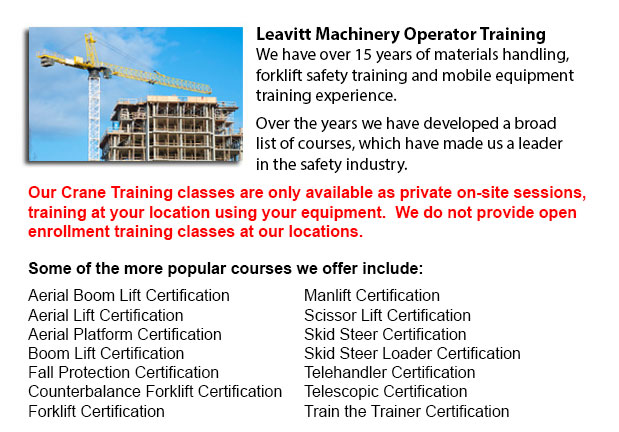
Mississauga Overhead Crane Safety Training - The overhead crane safety training course is meant to equip the operators with the right knowledge and skills in the areas of: crane safety precautions, materials handling, accident avoidance, and stock and equipment protection. Each of the trainees would get to learn on numerous types of overhead cranes, their capabilities and their uses in a wide variety of environments. For operators who are trained and licensed, the shift in liability moves from the company to the operator. Hence, the course emphasizes individual operator tasks.
Overhead crane safety training instructs operators in the correct methods for carrying out checks. Two kinds of pre-shift inspection are the walk-around inspection and the in-depth inspection. These are important every day routines which must be logged. Properly recorded pre-shift inspections help to protect the company from liability in case of an accident. Pre-shift inspections likewise prevent expensive repairs, accidents and damage. Operators learn how to designate a specific person to carry out checks, how to report problems, and how to maintain the log book.
Each inspection must be documented and carried out on a regular basis. Things that must be inspected for possible problems, comprise: hooks for cracks, increases in the throat opening, hoist ropes for corrosion, degree of twist, worn wires, loss of diameter, kinks and bird caging, broken wires, chains for nicks and gouges, heat and chemical damage, cracks and corrosion, twists, excessive wear, distortion, stretching, pits, damage caused by extreme heat.
Operators learn proper rigging procedures in this course. Rigging includes understanding the manufacturer's data plate, determining the weight of materials to be lifted, choosing the gear, and using safe practices to secure the load. The program cover in detail the following: safe working loads, and the capacities of chains, ropes, shackles, slings and hooks.
It is important to know who can use the cranes at your facility, physical requirements of the job, and operator credentials required for specialized tasks and permits. Safety must be prioritized when operating in the vicinity of pedestrian traffic.
Safe crane operation includes responsibilities such as checking for hydraulic leaks, undertaking visual inspections, testing the controls, checking the safety guards, examining the hoist rope and hook, limit switches and braking mechanisms. Correct reporting methods are vital. These subject matters are all covered in depth in the course.
The course also covers the right moving and lifting procedures with hoists and cranes. Operators would also learn correct hand signals. Training includes how to raise the load, attach the load, unhook the slings, abort a lift and set the load.
Moving the load includes a number of steps: stopping and starting procedures, guiding and controlling the load, observing working conditions and working with signals. Operators need to know how to proceed in the event of a power failure. The program includes techniques for lowering the load and removing the slings, parking the crane, storage equipment, and securing an indoor and outdoor crane.
-
Mississauga Crane Training Courses
Mississauga Crane Training Courses - The heavy equipment crane is intended to move, lift and lower heavy stuff. Normally, the crane comes outfitted along with a hoist, sheaves, and chains or wire ropes. Cranes are utilized in the manufacturing, const... More -
Mississauga Telehandler Ticket
Mississauga Telehandler Ticket - The telescopic handler or telehandler is a normally utilized machine in agricultural and industrial applications. This machine is the same in look to a forklift and even works in a similar way, even though telehandler... More -
Mississauga Overhead Crane Ticket
Mississauga Overhead Crane Ticket - An overhead crane is normally used in industrial environments. Likewise referred to as a bridge crane, this equipment includes parallel runways spanned by a traveling bridge. The component that lifts materials is t... More -
Mississauga Forklift Safety Training
Mississauga Forklift Safety Training - Any person who wants to operate a lift truck has to take a forklift safety training program in order to become a certified forklift truck operator. There are various ways to acquire forklift training. Courses ar... More -
Mississauga Heavy Equipment Training
Mississauga Heavy Equipment Training - Normally, the different kinds of heavy equipment training are divided into 2 categories of equipment: those that have rubber tires and tracked vehicles. Tracked vehicles include items such as excavators, cranes,... More -
Mississauga Loader Ticket
Mississauga Loader Ticket - Loaders have been created to operate practically anywhere. They offer optimal traction and maneuverability because of a heavy-duty oscillating joint which offers 45-degree rotating angles toward the left and right, with 10... More -
Mississauga Boom Lift Certification
Mississauga Boom Lift Certification - Elevated work platforms allow maintenance operations and work to be done at levels which can not be reached by whichever other means. Boom Lift Certification Training educates workers about safely operating boom... More -
Mississauga Forklift Training School
Mississauga Forklift Training School - Why A Forklift Operator Must Take A Forklift Training School - Federal and industry regulators have established the criteria for forklift safety training based on their existing standards and regulations. People... More

Forklift Certification Mississauga
TOLL FREE: 1-888-254-6157
Mississauga, Ontario
forkliftcertificationmississauga.com
Email Us
About Us


